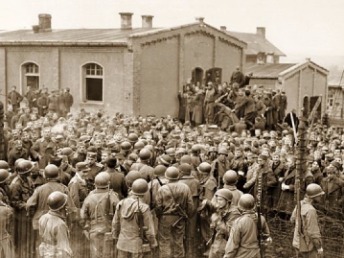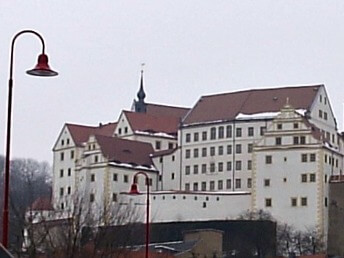- Home
- Stalag 13 Today
Stalag 13: Is It Still There?

Exploring the grounds of the former Stalag 13...
Whatever happened to the former Stalag 13, or "Stammlager XIII C" as it was officially known?
The camp, Lager Hammelburg, is still there, down the road from the town of Hammelburg, and is now the home of the German Infantry School (Deutsche Infanterieschule) for the modern German army, or Bundeswehr.
Most of the camp is now a restricted military area, but the main road south of Hammelburg goes through the eastern edge of the camp and many buildings can be seen from the areas accessible to the public.
See my article on the history of the real Stalag 13, Stalag XIII C.

The woods around "Stalag 13" naturally look nothing like the Southern California vegetation with fake snow you see Hogan and his men running around in!
 Restricted Areas at the Camp
Restricted Areas at the CampThe wooden barracks that housed the enlisted men of Stalag 13 C have been torn down, but some of the permanent buildings from the officers' camp, Oflag 13 B, are still standing.
 Lager Hammelburg
Lager Hammelburg Lager Hammelburg
Lager HammelburgFinding the Original Barracks
The tank has just broken through the fence surrounding the barracks holding the men of Oflag 13B, the officer part of the camp. The enlisted men were in Stalag 13C in the same camp.
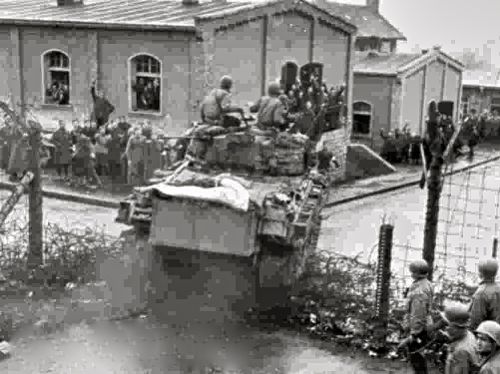 Liberation of the Camp
Liberation of the CampThe two officers' barracks in the photo above are still there.
They're in the restricted area, but easily viewed from a parking area next to the main gate.
On the map below, I've marked the locations of the first building and the tank, as well the main gate of the camp and a good spot for viewing the remaining buildings. (Thanks to Geoff Walden of thirdreichruins.com for identifying it.)
For more info, see my article on the history of Stalag 13.

Map data (c) OpenStreetMap and contributors, CC-BY-SA

Below you can see the two buildings that were nearest the tank in the camp liberation photo.
There was a lot of construction going on in front of the old camp barracks buildings when I took the picture.
 Two remaining barracks buildings from Oflag 13.
Two remaining barracks buildings from Oflag 13.The Camp Entrance
The main gate and entrance to the Deutsche Infanterieschule looks just about the same as it did years ago, except it has been spruced-up quite a bit.

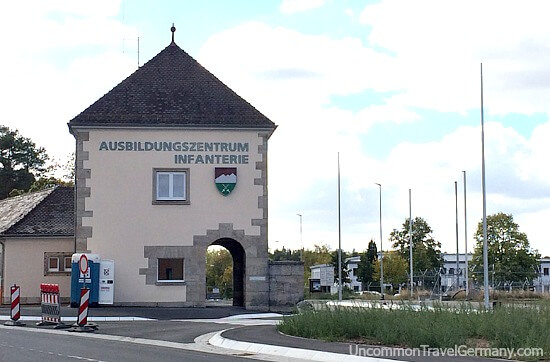 Current Entry Gate
Current Entry GateBonnland
Even the little village of Bonnland, taken over by the army during an expansion in 1938, is intact.
The residents were moved out and the deserted town is now used for urban warfare training. (See training video below)
 Bonnland
Bonnland(Image thanks to Denny Sander, CC-by-SA license.)
The POW Cemeteries
Prisoners of war from both WWI and WW2 were held at Lager Hammelburg.
These graveyards still contain the remains of some of the soldiers who died during captivity in both world wars.
Finding the POW Graveyard. Continuing along the main road (Rommelstrasse) will bring you into the camp, and turning right on Bonnlanderstrasse will take you past two well-maintained cemeteries. See map below.
When you turn right on Bonnlanderstrasse, you are leaving the public area of Lager Hammelburg and entering the training camp itself.
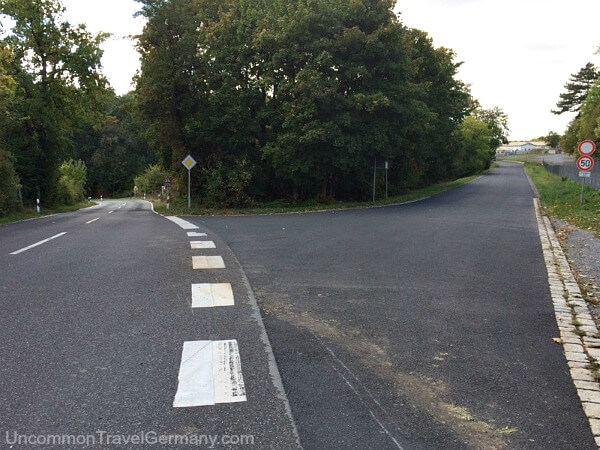 Bonnlanderstrasse on right, heading into the camp
Bonnlanderstrasse on right, heading into the campThere's a sign at the intersection directing people to the POW graveyard, but no warning that it's a restricted area, which it is.
 Sign for POW Cemetery
Sign for POW CemeteryYou may be stopped and asked to sign in at the camp office (just past the graveyard area) before exploring further.
They are understandably concerned with security, plus the safety of visitors, since the soldiers are training in the area.
The shooting ranges are just past the cemetery.
In the Cemetery
 Stalag 13C POW Cemetery
Stalag 13C POW Cemetery Russian Graves, Stalag 13C
Russian Graves, Stalag 13CAll of the American, British, Commonwealth, French and Italian men who were buried there were returned to their homelands after the war.
One cemetery holds the bodies of 2,987 Russian soldiers and the other graveyard has 35 Poles, 73 Yugoslavs and 44 Russians.

Marker in remembrance of the Soviet soldiers buried there.
 British POW grave marker, WWI
British POW grave marker, WWI POW Grave
POW Grave French POW Memorial
French POW Memorial Serbian Grave
Serbian Grave Serbian Grave
Serbian Grave Serbian Grave
Serbian Grave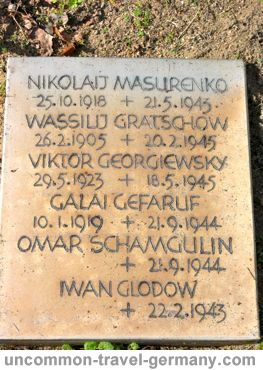 Russian Grave
Russian Grave Cemetery Notice About the Russian Graves
Cemetery Notice About the Russian GravesThe above notice was posted at the POW Cemetery, in German and Russian. The English translation is roughly:
"In the early 60's, the German War Graves Welfare Organization recovered 427 dead from temporary quarters in 76 Bavarian municipalities and placed them here for a lasting rest."
"In 1974, the organization gave this gravesite its lasting form. Reverence and sympathy watch over the peace of the dead."
A Peek Into the Camp
There are a variety of training areas and firing ranges inside the camp. This is the main training area for the German Infantry.
 Lager Hammelburg Training Area
Lager Hammelburg Training Area Lager Hammelburg, Wrecked M48 Patton Tank (American)
Lager Hammelburg, Wrecked M48 Patton Tank (American) Lager Hammelburg Firing Range
Lager Hammelburg Firing Range(Three images above thanks to Scheurebe2000, CC-by-SA license.)
Soldiers Training
Curious about what's happening in the former Stalag 13 nowadays?
Here's a YouTube clip of German soldiers training at Lager Hammelburg. Horseplay and urban warfare tactics in the ghost town of Bonnland, inside the camp.
The Bundeswehr in Hammelburg
True to Hammelburg's history as a garrison town, it is swarming with German soldiers...not surprising, being the home of the German Infantry School. I saw dozens of young soldiers coming and going from the Hammelburg Bahnhof and driving in and out of the town.
Service in the military is mandatory in Germany, although exemptions for conscientious objectors are readily given.
There are still residents living in Hammelburg who remember the POW's arriving at the train station. The building hasn't changed at all, except for a swastika scraped off one side.
The Bahnhof is just a short walk from the town center.
 German Soldiers at the Bahnhof
German Soldiers at the BahnhofVisiting the Camp
Lager Hammelburg is only about 2 and 1/2 miles (4 km) south of Hammelburg along the main highway.

It can be reached easily by bus if you're without a car.
Bus #8164 from the bus station (Busbahnhof) on Weihertor Platz in Hammelburg travels out to the camp many times a day.
You can get the schedule from the Tourist Office on the Markt.
There are three stops in the camp; if you get off at the first stop, "Lager, Saaleck Kaserne", you can walk the length of the camp from there.
Follow the road Rommelstrasse in the same direction and it will take you through the eastern edge of camp, past the main gate and many buildings.
Turn right on Bonnlanderstrasse as the fence turns and you will reach the cemeteries and the firing range.
Map of Lager Hammelburg
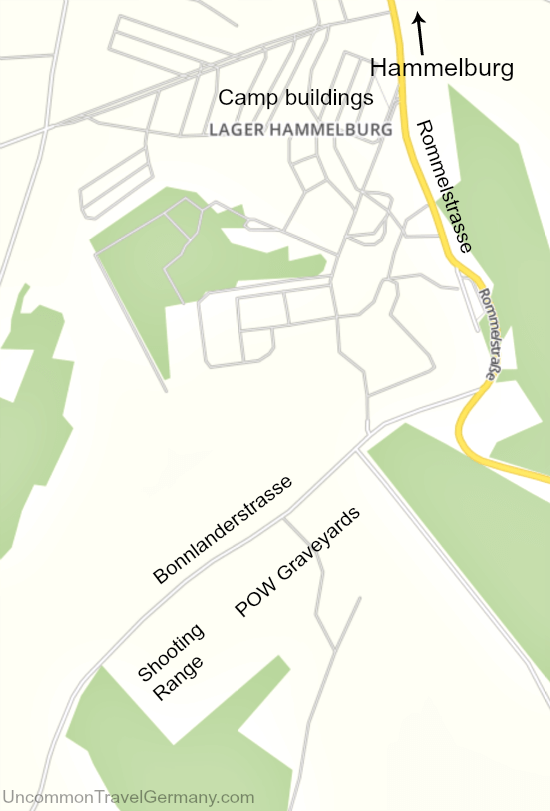
Map data (c) OpenStreetMap and contributors, CC-BY-SA
Map of Hammelburg and Camp
 Hammelburg and Lager Hammelburg
Hammelburg and Lager HammelburgMap data (c) OpenStreetMap and contributors, CC-BY-SA
The "Real" Stalag 13
Was there a commandant with a monocle? To find out what the camp was really like, check out the history of Stalag 13, and get the scoop on the town of Hammelburg nearby.
See how the POW camp in Hogan's Heroes compared with the real thing.
Were any of the characters in Hogan's Heroes based on real people? See which characters were "borrowed" from real life (or other shows and films) in Hogan's Heroes' origins.
More Stalag 13s...
There were four Stalag 13s in Germany.
Near the town of Weiden, east of Nuremberg, there was a POW camp called Stalag XIII B. Take a look at Stalag 13 B to read about the experiences of two of the Polish POW's there.
Stalag XIII A was located near the town of Sulzbach nearby. See Stalag 13A for photos and story of one of the French POWs in that camp.
Another Famous POW Camp
During WW2, Colditz Castle was a notorious POW camp that held mostly British and Commonwealth POW's. They were the "bad boys" who had escaped from other camps, and their exploits have become the subject of many books, movies and TV shows.
See what Colditz was all about, and how to visit it.
More to explore...
Share this page:
